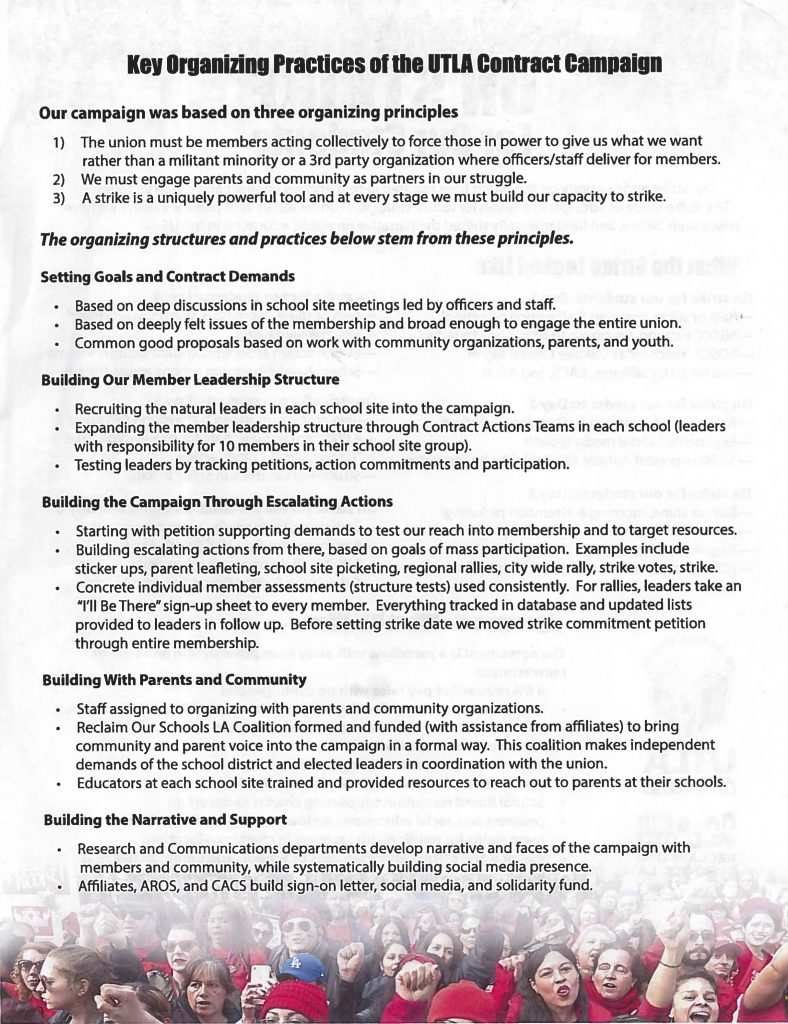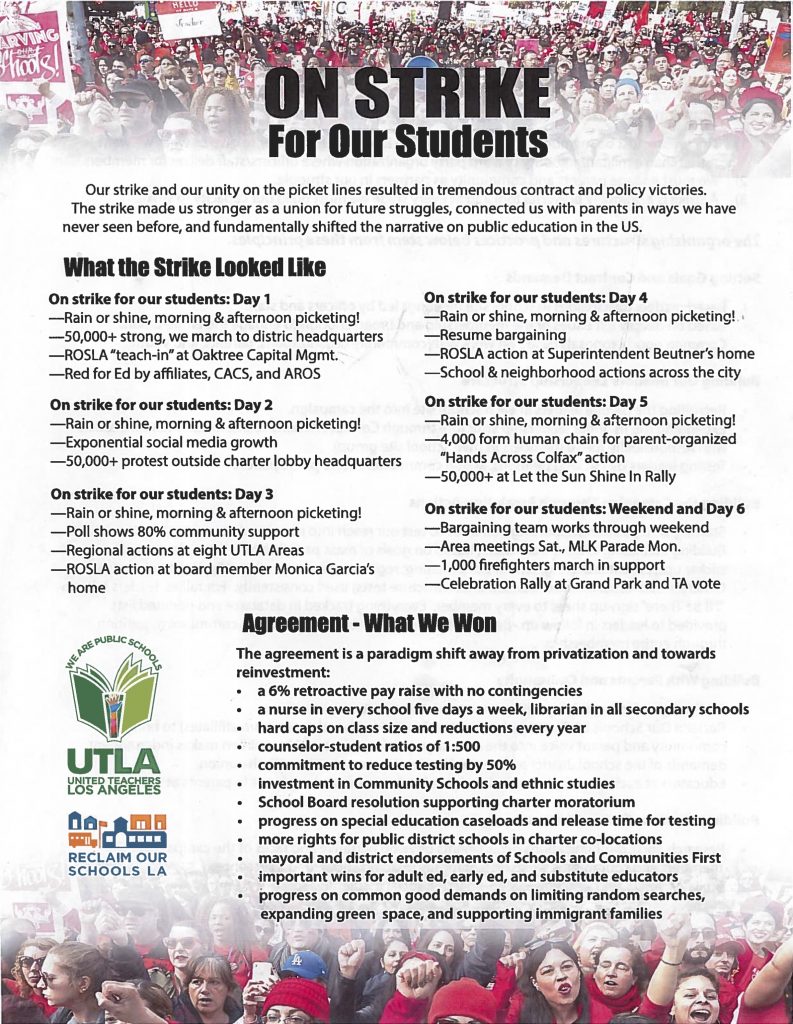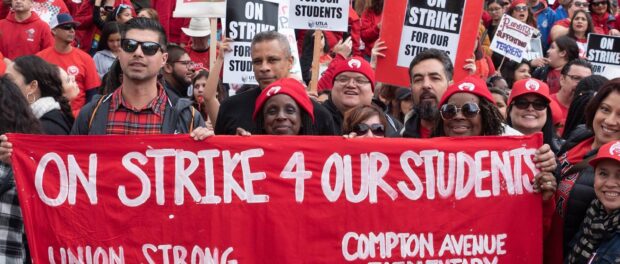
In January, tens of thousands of teachers mobilized across the city of Los Angeles for a six-day strike to protest low wages and a lack of support for students in public schools across the district. United Teachers of Los Angeles (UTLA), a teachers union boasting a membership of 30,000, organized the walkout and ultimately negotiated a settlement agreement with the Los Angeles Unified School District (LAUSD).
Over the course of the strike, approximately half a million students experienced school shutdowns and an estimated 60,000 people took to the rainy streets of L.A. in solidarity with teachers and students. The walk-out was set against the backdrop of what some have called a statewide crisis in public education, characterized by large classroom sizes, stagnant educator wages, teachers working multiple jobs, and deteriorating classroom facilities. The UTLA strike was the largest of its kind since the U.S. Supreme Court’s June 2018 ruling on Janus vs. the American Federation of State, County and Municipal Employees (AFSCME), which, many say, represents a threat to the future of public sector unions in the United States.

Meanwhile, in Brazil public education experiences similar challenges, to an nth degree. The global rankings tell a discouraging story of the world’s 9th biggest economy: according to the Organization for Economic Cooperation and Development’s (OECD) 2015 Programme for International Student Assessment (PISA), out of seventy countries measured, Brazil ranked 63rd in sciences, 59th in reading, and 66th in mathematics in terms of student achievement.
In Rio de Janeiro, the state teachers union (SEPE RJ) organized a strike beginning in March 2016 to bring attention to frozen teacher salaries, overcrowded classrooms (evidenced by student-to-teacher ratios as high as 50:1), and the devaluation of teachers and public education at the national level. During their nearly five-month-long strike, thousands of teachers—with the backing of students who simultaneously occupied dozens of schools in protest of education disinvestment in the state of Rio—endured police violence to voice their discontent with working conditions, demand salary increases, and denounce what many labeled a misuse of government funds on Olympic stadiums at the expense of public education.
In Los Angeles, the strike settlement reached between UTLA and the school district attests to the power that this teachers union holds at the moment. The agreement includes a 6% pay raise for teachers, a progressive annual reduction in class sizes, and the adoption of a resolution asking for a moratorium on charter schools. The school district also agreed to allocate $403 million toward greater support services in schools—including hiring full-time nurses in schools five days a week, staffing librarians in all secondary schools, and ensuring a ratio of one counselor per 500 students. UTLA secured promises for additional support for special education, as well as adult education, early education, and substitute teachers. (A summary of the settlement can be found here and the full text of the tentative agreement can be found here). Praised by union members as an “overwhelming victory,” the agreement may represent the beginnings of a “paradigm shift away from privatization and towards reinvestment” in public education.
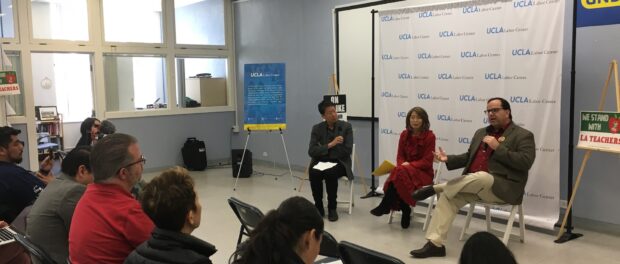
In late February, UTLA President Alex Caputo-Pearl and UTLA Secretary Arlene Inouye sat down at the UCLA Labor Center near downtown Los Angeles for a public conversation about organizing strategies, the larger social justice movement in the U.S. school system, and the future of quality public education. Their words may prove instructive for labor organizers both in the United States and Brazil. Nine reflections and lessons from the strike are laid out below:
1. The National Context: The Role of Privatized Education in Brazil and the US
Both the United States and Brazil are experiencing heightened trends of school privatization at the national level. In Brazil, educational outcomes are increasingly stratified by race and socioeconomic status thanks to a highly privatized school system, in which approximately one in four students aged six to fourteen attends private school. These private schools typically demand tuitions that only middle and upper-income families can afford, which, in turn, means that public schools are largely attended by students of lower-income backgrounds. The result is a form of educational apartheid whereby public schools are kept chronically underinvested and precarious, thus helping to maintain Brazil’s severe inequality, which is rooted in the nation’s neglected history as the world’s largest slave-holding society and the last in the Americas to abolish slavery.
In the United States, many point to charter schools as the form of privatization that jeopardizes the quality of public education. Conceived initially as an innovative approach to engage struggling students, the charter model has been widely adopted by for-profit interests that build new schools in neighborhoods with already-standing public schools and compete with public institutions for students and funding. These publicly funded, privately managed charters have grown rapidly over the past decade—but especially in Los Angeles, which is home to 277 charter schools and a body of largely non-unionized teachers.
A recent U.S. Supreme Court decision adds to the challenges facing public sector unions like UTLA. In the case of Janus vs. AFSCME in June 2018, the Court delivered a sharp blow to public sector unions when it ruled that non-unionized workers could not be forced to pay fees to public sector unions that may represent them. The decision represented the overturn of forty years of legal precedent, leading many U.S. unions to fear that it will weaken their collective bargaining power by disincentivizing union workers from paying dues, thus gutting union membership and funds (a classic example of a “free-rider” problem).
2. A New Strategy in Los Angeles: Striking for More than Teacher Pay—Bargaining for the Common Good
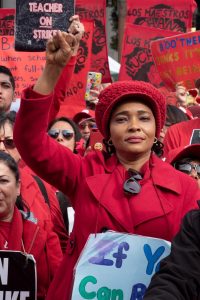
Despite these legal obstacles, in Los Angeles, the teachers union’s response to the Janus ruling tells a story of hope. UTLA leaders report that their membership grew by one thousand in the past year, a trend that is counterintuitive to the union backlash anticipated by the court ruling’s conservative backers. Furthermore, UTLA members voted by an overwhelming majority (80%) for a union dues increase following the court case, in large part due to effective education campaigns by union leaders.
“The gains we made speak to the power of the collective and the power of a strong team,” said UTLA President Alex Caputo-Pearl, who advocated for the approach of “bargaining for the common good,” a growing national movement that puts community interests at the top of the agenda. As early as 2017, UTLA circulated a member survey to assess bargaining goals, while simultaneously meeting with parents for feedback on the most pressing issues facing the community. “By the time we got to the bargaining table, we were taking demands and proposals that had come out of months of working with community organizations, youth, and parents, and that brought to light things that are not typical, mandatory subjects of bargaining,” Caputo-Pearl described.
“By the time we got to the bargaining table, we were taking demands and proposals that had come out of months of working with community organizations, youth, and parents, and that brought to light things that are not typical, mandatory subjects of bargaining.” — UTLA President Alex Caputo-Pearl
Among the results of this engagement was a proposal for LAUSD to set up a million-dollar legal defense fund for undocumented students and family members, as well as a call to end police random searches of students on school campuses, which frequently result in racial profiling of black and Muslim students. Practices like these “break trust [between students and authorities], and disrupt school hours,” said the president. Similarly disturbing accounts can be found in Rio de Janeiro, where Military Police routinely interrupt class time to conduct violent operations.
Yet another unusual component of UTLA’s proposal focused on increasing green space at schools, backed up by research that a lack of greenery increases student anxiety. By addressing immigrant rights, racial justice, and other issues, UTLA broadened its platform to encompass causes that may fall outside the union norm but that nevertheless “sustain the civic institution of public education.”
3. Setting Up a Game Plan: Building Community Structures and Support
UTLA carefully laid the groundwork for the strike through community appeals, a potential lesson for organizers across the United States and Brazil. During the public conversation, Caputo-Pearl talked about his community organizing background and UTLA’s decision to massively rethink its engagement with parents and communities on two critical fronts. The first was building a community coalition which they called Reclaim Our Schools LA, bringing together teachers, parents, students, as well as civil rights organizations, community organizations, and youth organizations with the goal of democratizing Los Angeles’s public education system and improving access for students of all races, socioeconomic backgrounds, geographies, and educational needs.
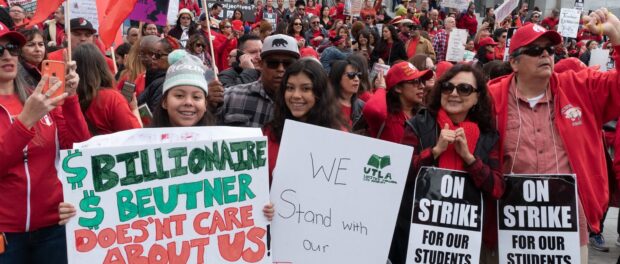
The vast majority of parents in the L.A. Unified School District, however, do not belong to any community organization. Thus, the union’s second engagement strategy centered on training UTLA members to talk directly to parents about the ongoing structural threats to education. “Teachers love to talk to parents about how their students are doing,” Caputo-Pearl stated, “but breaking the seal to talk about politics, power, and organizing has been a central project for UTLA’s work over the last four years.” During the strike, he added, “that seal came all the way off.” Polls of L.A. residents taken during the strike showed that 80% of the city’s residents supported teachers and unions. That support could be felt in the streets, where 60,000 demonstrators turned out in front of L.A. City Hall during contract negotiations between LAUSD and UTLA.
“Teachers love to talk to parents about how their students are doing, but breaking the seal to talk about politics, power, and organizing has been a central project for UTLA’s work over the last four years.” — Caputo-Pearl
UTLA leadership credits effective community engagement strategies as responsible for the strong showing of pro-union support. These lessons may be borne out in Rio de Janeiro, particularly in the city’s favelas—many of which suffer from a critical shortage of public schools, leading parents to shoulder extra public transportation costs and lengthy commutes to bring children to school in adjacent, or sometimes distant, neighborhoods. Appealing to families on the grounds of broad educational reform may hold promise for future teachers movements in Brazil.
4. Flipping the Script on Unions: Acknowledging Legacies of Racial Oppression
Another key element of building public union support is refuting the negative popular narrative attached to labor movements. In Los Angeles, UTLA leaders are the first to acknowledge Americans’ tendency to blame “bad teachers” for the declining state of the educational system. In order to flip this script, UTLA organizers set up a “communications game plan” to capture public support for their cause. In the four years leading up to the strike, UTLA established a research division to investigate forces behind the privatization of the educational system, reporting their findings to the broader community. They also recruited social media influencers from among union membership to highlight the stories of teachers, librarians, nurses, and allies from the community. “By bringing real members’ stories to the forefront, we highlighted our greatest asset: our membership,” said Inouye, UTLA secretary. “That’s what captures people.”
“By bringing real members’ stories to the forefront, we highlighted our greatest asset: our membership.” — UTLA Secretary Arlene Inouye
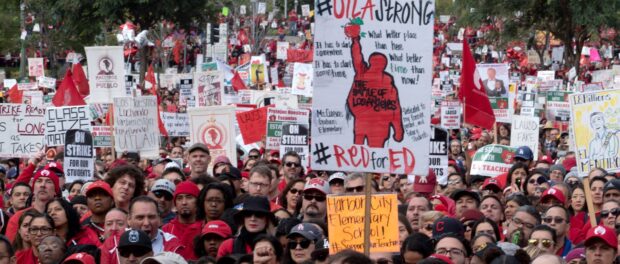
Caputo-Pearl also credits the shift in the union’s public image to UTLA’s decision to embrace larger conversations around race and oppression. “Another piece of the narrative is not being afraid to talk about things that are uncomfortable,” he said. “We have talked about racial justice from the beginning, which has led to some challenging conversations, but we’ve plowed through it.” Confronting a broader political context, Caputo-Pearl believes, is a break with the “lowest common denominator type of messaging” that fueled decades of public frustration with unions.
“Another piece of the narrative is not being afraid to talk about things that are uncomfortable. We have talked about racial justice from the beginning.” — Caputo-Pearl
This type of appeal could be highly applicable to the Brazilian context, where all levels of the public education system continue to feel the effects of racial injustice. Like the United States, Brazil sees enormous disparities in educational attainment—again, to an nth degree—between Afro-Brazilian and white students. Students are routinely subjected to violence and racial profiling at school and on the way to and from school, including police searches in the name of public security. In the big picture, education inequality is a well-documented contributor to later incarceration via the school-to-prison pipeline, which puts black and brown children from lower-income neighborhoods at heightened risk of entering the criminal justice system. By tapping into a larger conversation about racial oppression, union organizers in Brazil’s underserved communities may generate the same support that UTLA enjoyed during the Los Angeles teachers strike.
5. You Must Be Willing to Strike [Back]: The Power of the Strike
In order for labor movements to meet their goals, strikes must be understood as a legal and acceptable bargaining tool. As Caputo-Pearl put it: “If you are bargaining and trying to win but you’re not willing to strike, you’re not doing right by your union members.” During the conversation at UCLA’s Labor Center, speakers and audience members alike expressed frustration with California’s Democratic leadership and the L.A. School Board, both of which opposed the strike by a 70% female workforce. “This party that tells us they’re for women’s rights is simultaneously doing everything they can to jam up a majority-women workforce,” Caputo-Pearl stated. “There was something very guttural about that.” Still, in spite of opposition, Caputo-Pearl believes that “strike cannot be a bad word” and that the labor movement—in the United States and across the globe—must be willing to take this step in order to make further gains in the future.
6. Stronger Together: Engagement Across Municipalities
Discussion between different municipalities, whether in the U.S. or Brazil, generates greater public union support and fosters a richer dialogue on organizing strategies. Indeed, the strike in Los Angeles was neither the first nor last major successful teacher protest in recent U.S. history. In March 2018 roughly 20,000 teachers across every county of the Appalachian state of West Virginia staged a nine-day strike to bring attention to low teacher salaries. (In February, these teachers shut down schools for a second time to protest a state bill supporting charter schools and other privatization measures). “We can thank West Virginia and other politically red states for elevating their desperate situation [to the national spotlight] in terms of the lack of pay and lack of respect that educators are experiencing,” said Caputo-Pearl.
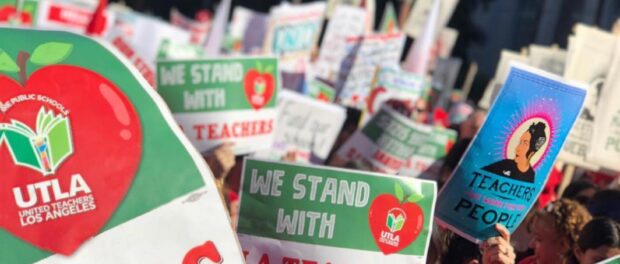
The Los Angeles teachers strike bolstered this narrative in a new part of the country, and, in turn, prompted a ripple effect of its own. In late February, approximately 3,000 teachers from the Oakland Education Association went on strike, listing a similar set of demands as UTLA members: higher wages, smaller classes, more support services like counselors and nurses, and an end to school closures. Teacher strikes are also anticipated in the California communities of Madera County and Sacramento.
7. Questions Over Education Funding: The U.S. and Brazil
In both the United States and Brazil, funding for public education continues to be a source of conflict and uncertainty. The Brazilian legislature’s 2016 passage of the proposed constitutional amendment PEC 241/55 ushered in stringent fiscal austerity measures, leading professors like Pedro Paulo Zahluth Bastos from the University of Campinas to predict future education spending per child will drop to almost a third of 2017 levels. The electoral victory of far-right politicians on national and state levels in the 2018 Brazilian general election has all but ensured further spending cuts.
In Los Angeles, even as teachers and organizers celebrate a victory, questions remain about how LAUSD will afford the settlement agreement. A neutral fact-finding report published by Najeeb N. Khoury, appointed as a mediator to oversee negotiations, cited California’s “complicated and flawed” funding system—combined with a “proliferation” of charter schools—as hurdles that California school districts will face in meeting teachers’ demands. Los Angeles District Superintendent Austin Beutner, who the union has publicly reviled as a pro-charter privatizer, has stated his “tremendous concerns about insolvency,” alleging that the district may face financial collapse in two to three years if it fully funds all parts of the settlement. UTLA disputes this claim, citing the $1.86 billion dollars that LAUSD holds in reserve. Another neutral fact-finding panel confirmed the existence of these assets but acknowledged that the majority of funding is already allocated for other planned expenditures.
The LAUSD-UTLA settlement agreement states that the district, the union, and the mayor will work together to advocate for funding from both state and county levels. Los Angeles Mayor Eric Garcetti has agreed to back the plan, but it remains to be seen how the state that places 43rd out of 50 states in per-pupil funding will address these challenges.
8. After a Successful Strike: How to Sustain Momentum?
To continue expanding its efforts following a strike, organizers must not let up on mobilizing public support for teachers unions and high-quality public education. In Los Angeles, UTLA leaders highlighted the upcoming elections in November 2020 as a potential opportunity for transformative local change in the form of the Schools and Communities First initiative. This measure, if passed via statewide referendum, would eliminate the corporate property tax loophole in California’s Proposition 13, a ballot measure passed in 1978 that effectively caps statewide property tax increases, thereby limiting state revenues. Supporters say that the Schools and Communities First measure, if passed, would require commercial properties to be taxed at full value, generating an additional $11 billion dollars for California public services like affordable housing, infrastructure, healthcare, and, of course, education.
Last August, the campaign announced that they had received the 860,000 signatures required to place the initiative on the 2020 ballot. The measure is endorsed by Mayor Eric Garcetti, as well as the League of Women Voters of California, PICO California, California Calls, Advancement Project California, Evolve California, Common Sense Kids Action, Alliance San Diego, the Coalition for Humane Immigrant Rights of California (CHIRLA), and the California Federation of Teachers.
9. Strikes as Transformative Movements: ‘This is What Freedom Feels Like’
The fight for public education, regardless of locality, can unite union members, students, parents, and community members. “One of the unique powers of a strike, in addition to winning things, is that people get changed and transformed,” said UTLA President Caputo-Pearl. Reminiscing on his many conversations with L.A. teachers, Caputo-Pearl recalled countless stories of uplift and increased morale. “Teachers love the fact that four out of the six days of the strike were in the rain. It makes the whole thing epic,” he recounted. One teacher described a marked shift in the faculty dynamic at her school. Caputo-Pearl quoted her testimony: “For ten years, people didn’t eat together in the lunch room and now we all do.”
“For ten years, people didn’t eat together in the lunch room and now we all do.”
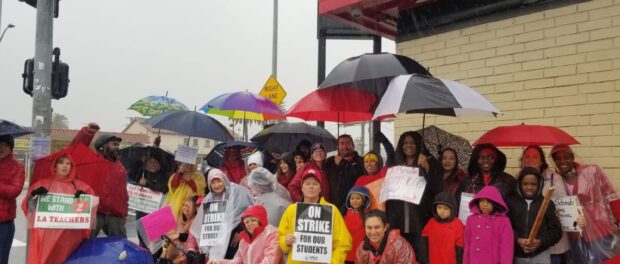
Other Los Angeles teachers reported nostalgia for the strike, recalling “how well [they] got to know other people in our workplace and the parents.” Jorge Lopez, a teacher and racial justice educator from East L.A., described to Caputo-Pearl the feeling of marching through his community and seeing people come out of their houses to join in the march. “This is what freedom feels like,” Lopez remarked. “Doing something collective during the workday in the fight for public education.”
Despite financial uncertainty and a grim national climate, the prevailing mood amongst Los Angeles teachers is one of optimism. The promise of public reinvestment in education, along with this renewed solidarity, sends a hopeful signal—and package of successful strategies—to union leaders everywhere.

